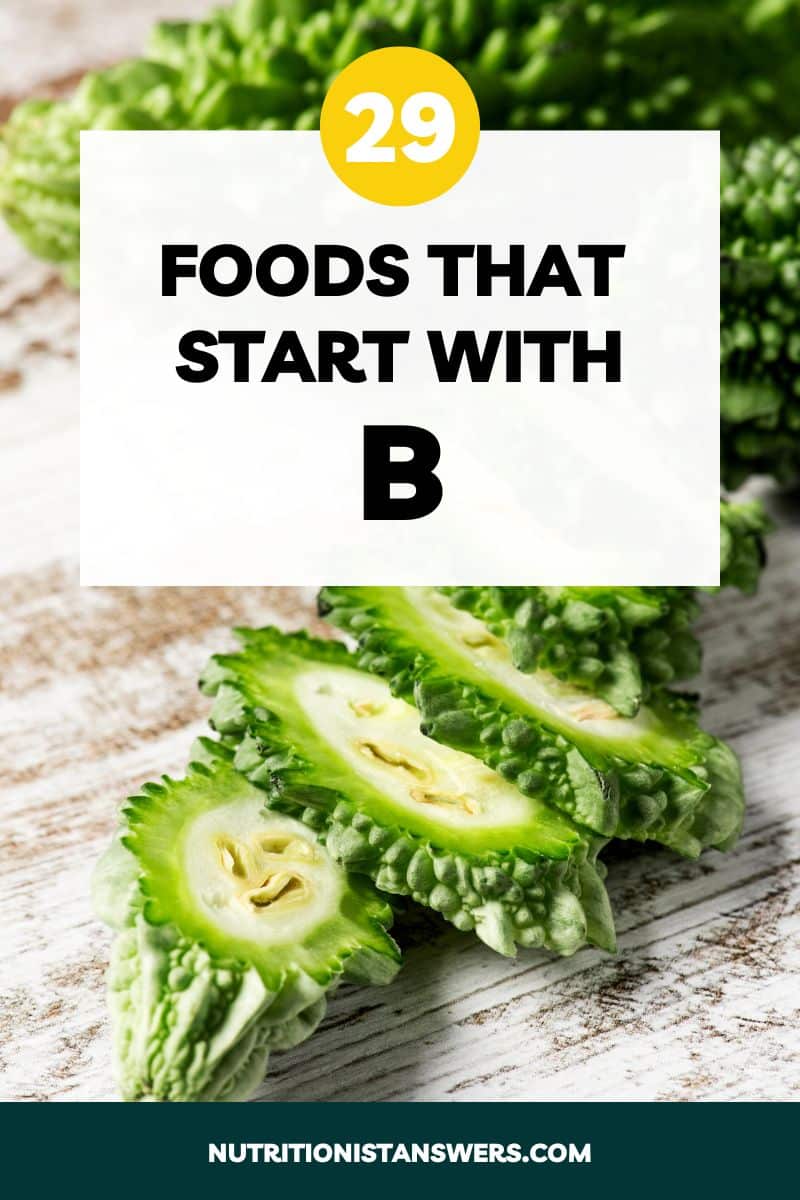Looking for an extensive list of foods that start with the letter B?
Look no further, we’ve got you covered!
Browse this list of 29 foods that start with B to get some new cooking inspiration, learn more about where each food comes from, and understand the health benefits of each food.
Let’s dive in!
Please note that this article contains affiliate links. If you click one of these links and make a purchase, we may earn a commission. As an Amazon Associate, we earn from qualifying purchases.
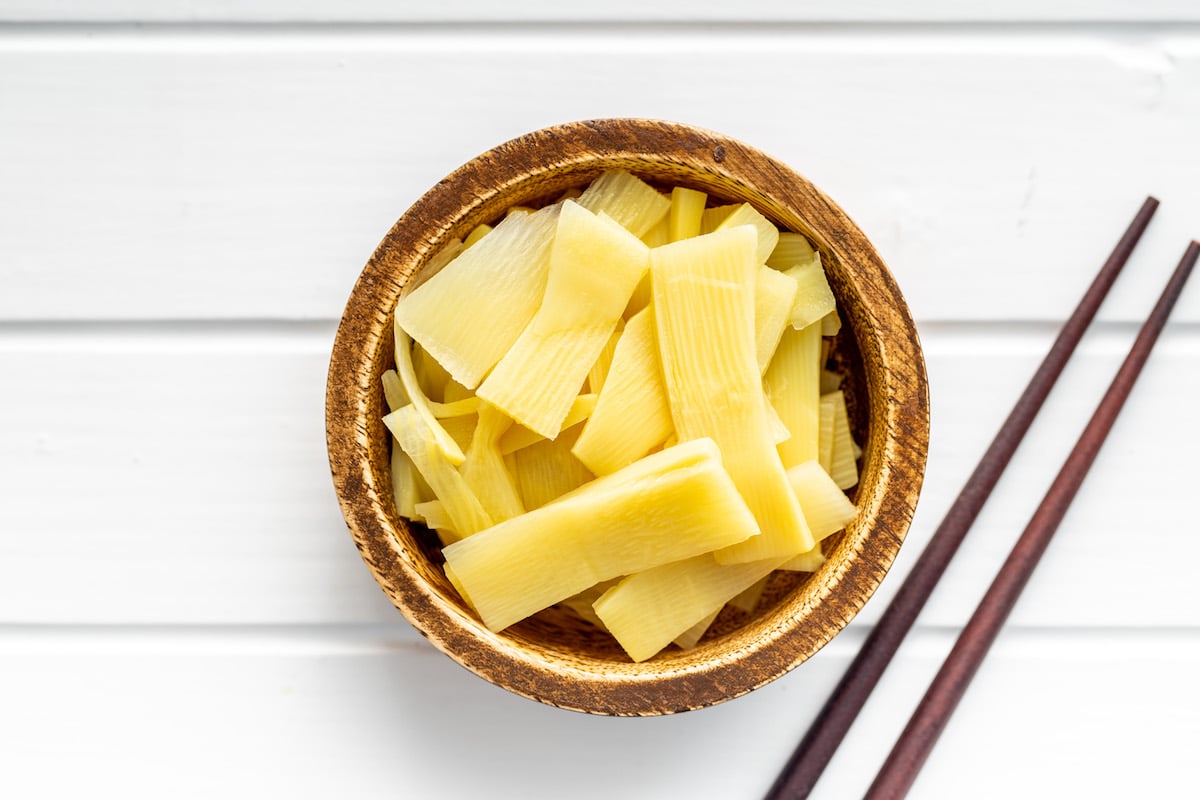
1. Bamboo shoots
Bamboo shoots are the young, tender shoots of certain species of the bamboo plant, a tree-like grass that grows all over the world (1, 2).
They are long and cylindrical with crisp, ivory-colored flesh that tastes very mild — slightly sweet and earthy, with a hint of nuttiness.
Fresh bamboo shoots contain taxiphyllin, a naturally-occurring plant chemical that can be converted to cyanide by the body.
To prevent cyanide poisoning, it is recommended to cook bamboo shoots before eating them, because this breaks down taxiphyllin (3, 4).
Canned bamboo shoots can be found at most supermarkets, while dried, fresh, or frozen bamboo are sometimes available at Asian markets and specialty produce stores.
Bamboo shoots are very popular in Asian cuisine and make a great addition to stir-fries, soups, and salads.

2. Bananas
Bananas are one of the oldest and most popular fruits in human history. They originated in Southeast Asia and are now grown in tropical and subtropical climates worldwide (5, 6).
There are more than 1000 varieties of bananas, but the most common is the Cavendish, which starts out bright green and turns yellow as it ripens (7).
Yellow (ripe) bananas are sweet and soft, while green (unripe) bananas are firm, astringent, and slightly bitter.
Interestingly, green bananas are a good source of resistant starch, a type of fiber that helps prevent blood sugar spikes and promotes the growth of beneficial gut bacteria (7, 8, 9).
At the grocery store, you’ll find fresh bananas, as well as frozen sliced bananas, dried or freeze-dried banana pieces, and banana chips (sliced bananas fried in oil and sweetened with sugar).
Bananas are a convenient and nutritious snack on their own, but they’re also delicious in smoothies, yogurt, cereal, and baked goods.
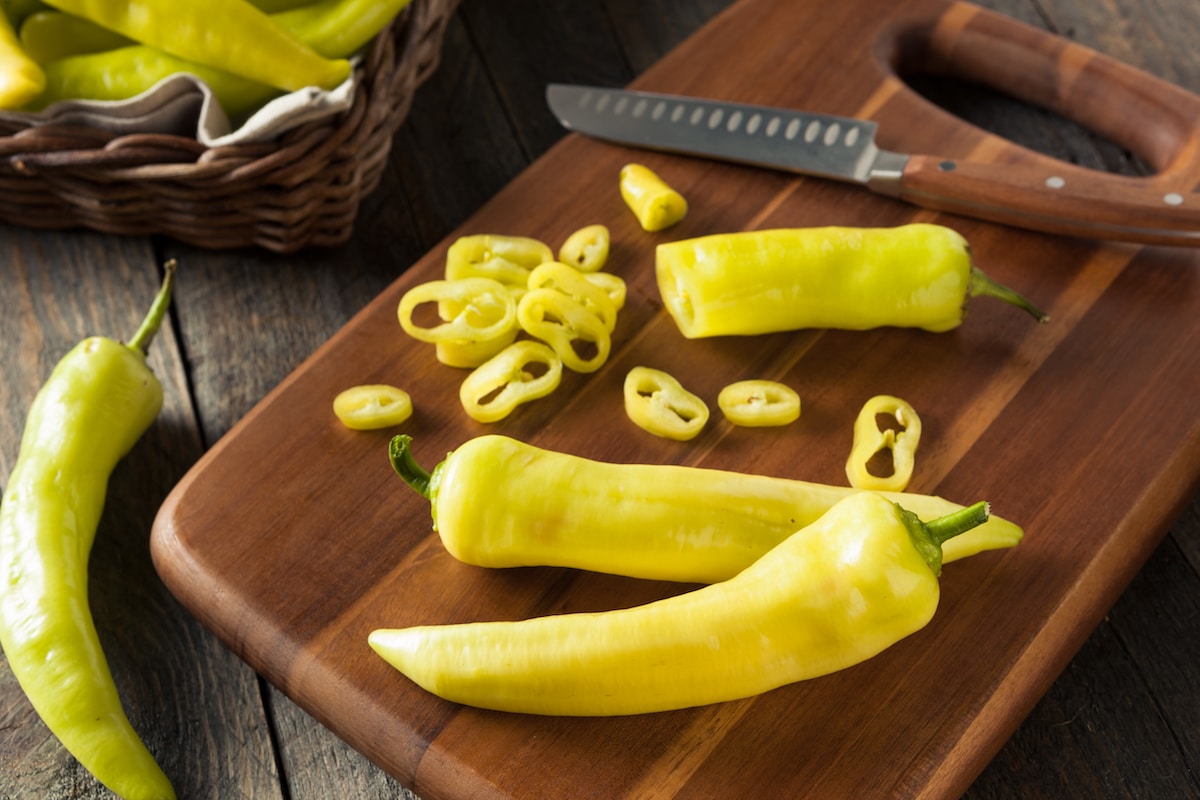
3. Banana peppers
Banana peppers are a variety of chili pepper (Capsicum Annuum) known for their mild, tangy, and slightly sweet flavor.
They get their name from their curved, banana-like shape and bright yellow color, although they can also turn orange or red as they ripen.
Compared to other peppers, banana peppers aren’t very spicy, measuring between 0 and 500 SHU on the Scoville scale. For reference, jalapenos range from 2,500 to 8,000 SHU (10).
Banana peppers are rich in vitamin C, providing more than 100% of the Daily Value in a single cup (124 grams) (11, 12).
Some grocery stores carry fresh banana peppers in the produce section, but pickled versions (usually sliced and found in the condiment aisle) are more widely available.
Both fresh and pickled banana peppers are perfect for adding a little extra flavor to sandwiches, salads, pizzas, and more.
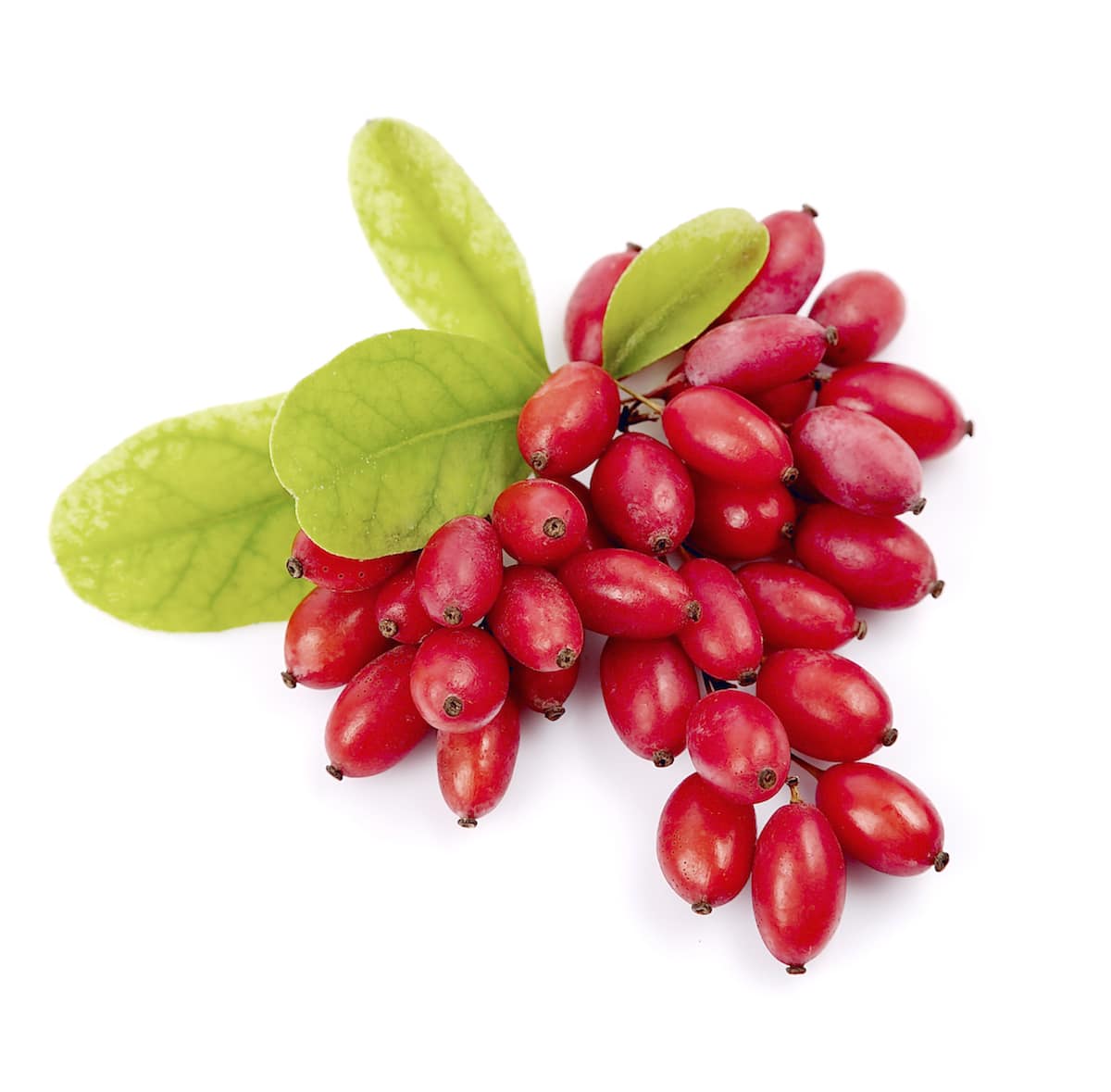
4. Barberries
Barberries are the fruits of Berberis vulgaris, a shrub native to Asia, Europe, Africa, North America, and South America. They are especially popular in Iran (13).
These bright red berries are very small (less than 1 centimeter in length) and oblong with smooth, shiny skin and tart, juicy flesh that tastes similar to cranberries.
Barberries are high in berberine, an alkaloid compound that may help improve blood sugar levels and lower LDL cholesterol in people with type 2 diabetes (14, 15).
Fresh barberries typically aren’t available in the United States. Instead, you’ll find dried barberries at Middle Eastern food markets, or you can purchase some online here.
Dried barberries make a fabulous addition to rice pilafs or couscous dishes, but make sure to soak them in hot water beforehand for optimal flavor.

5. Barley
Barley is a gluten-containing cereal grain that was first domesticated at least 10,000 years ago and is now grown worldwide (16).
Its grains are small and round, and can be various shades of yellow, brown, or red. When ground into flour, they have a light color and a slightly grainy texture.
Barley has a chewy texture and a mildly nutty, earthy flavor, similar to brown rice. It pairs well with other earthy flavors, such as mushrooms and root vegetables.
One cup (170 grams) of cooked barley provides 4 grams of protein, 6 grams (21% DV) of fiber, 2.2 mg (12% DV) of iron, 1.4 mg (13% DV) of zinc, and 3.5 mg (22% DV) of niacin (11, 17).
Most grocery stores carry pearl barley, which has had the bran removed. The whole grain form of barley — called hulled barley — is available online and at some health food stores.
Barley can be cooked and eaten as a hot cereal, tossed into salads, added to soups and stews, or used as a side dish.

6. Basil
Basil (Ocimum basilicum) is a well-known herb that belongs to the mint family. It is native to India, Asia, and Africa but is now grown all over the world (18).
There are many varieties, including lemon basil and cinnamon basil, but sweet basil and Thai basil are the most common.
Sweet basil has glossy green leaves that taste mildly sweet and peppery, while Thai basil leaves are skinnier and purple-tinged with a stronger anise-like flavor.
Though you can usually find fresh, dried, or even basil paste at the grocery store, it’s just as easy to grow your own.
Use fresh basil to make pesto and other condiments, or add some to pasta dishes, salads, pizzas, and stir-fries. Dried basil is perfect for seasoning soups and breads.
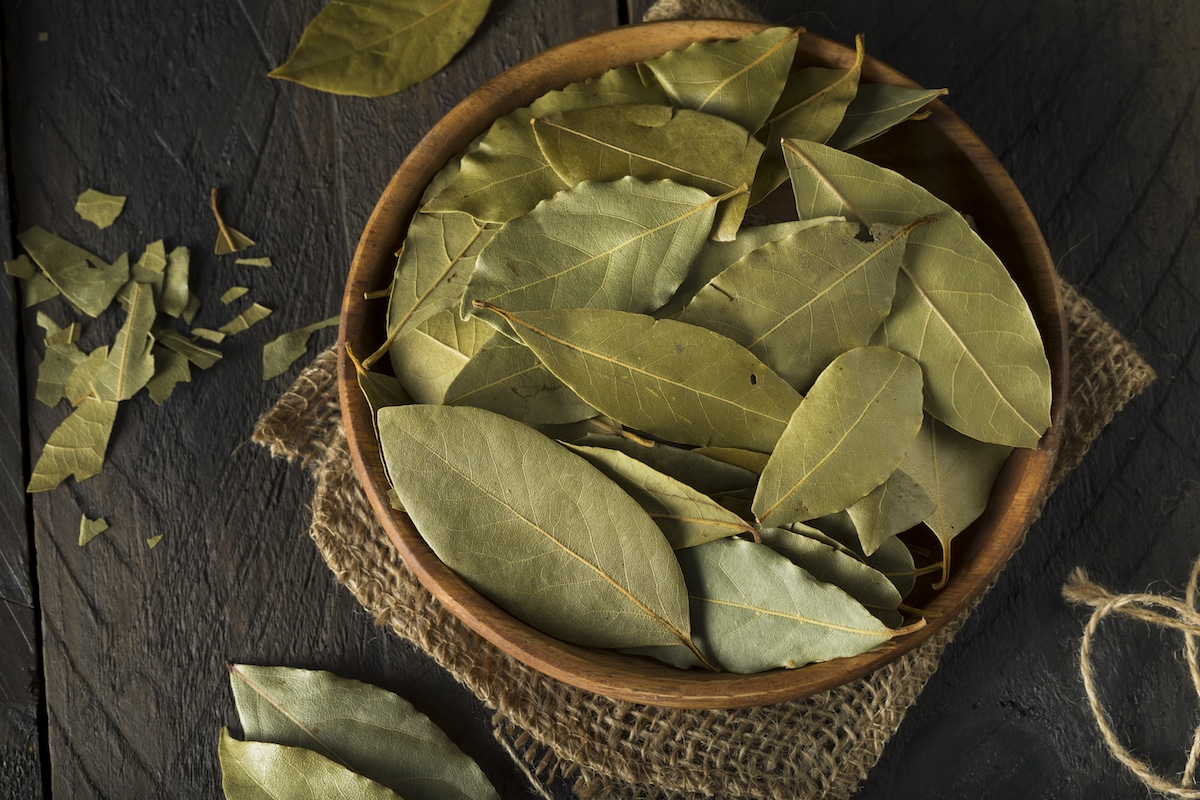
7. Bay leaves
Bay leaves (also known as bay laurel) are the leaves of Laurus nobilis, an evergreen shrub native to the Mediterranean region (19, 20).
They’re typically used as an herb and are removed from foods before serving, because they are very difficult to chew and can pose a choking hazard.
Bay leaves are long and narrow with a pointy tip. They are greenish brown in color and have a stiff, leathery texture.
Their flavor is unique — woodsy and bitter, with hints of eucalyptus, mint, oregano, and pine.
Although fresh bay leaves are sometimes available, you’re more likely to find them dried in the herbs & spices aisle at most grocery stores.
Use them to season soups, stews, meats, and other dishes, or add them to a pot of beans or rice while cooking.
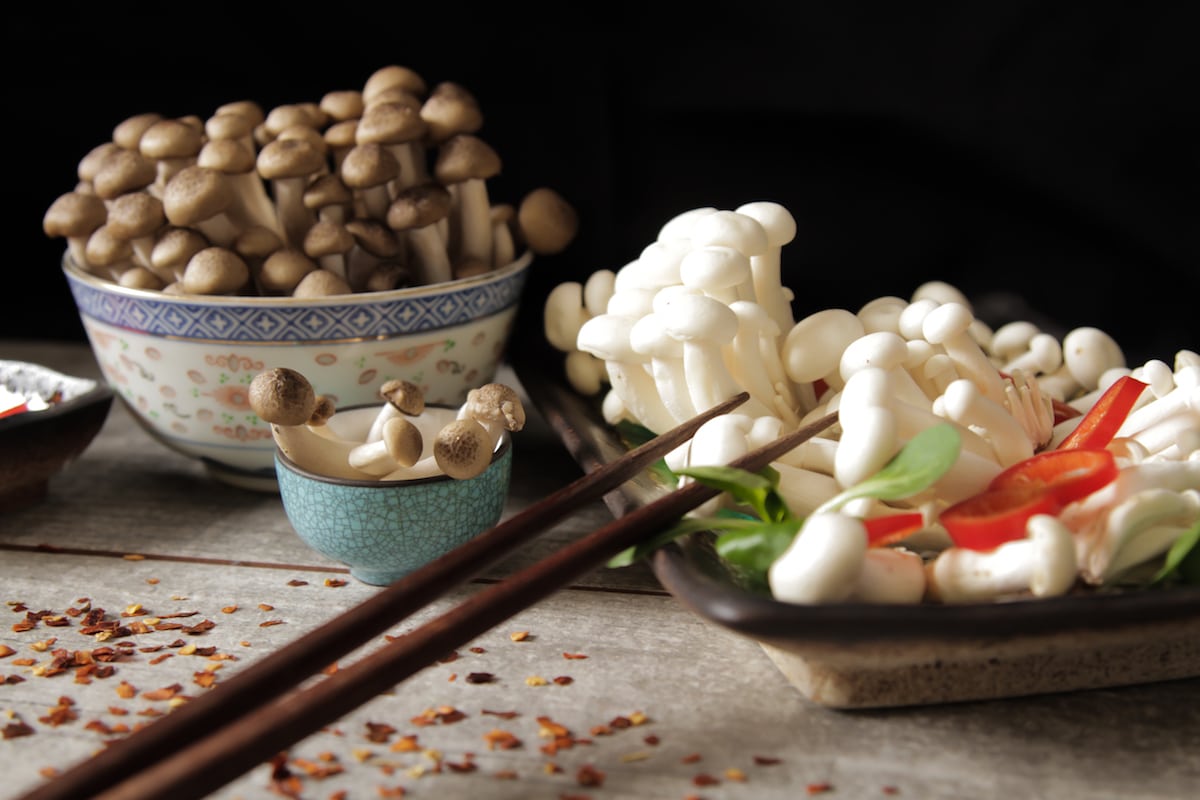
8. Beech mushrooms
Beech mushrooms (Hypsizygus tessellatus) are an edible species of fungus that are often found on dead and decaying beech trees, hence the name.
They grow in clusters and have long, slender stems with small, round caps that can be either white or mottled brown.
Beech mushrooms have a rich, umami flavor and a chewy texture, making them a great meat alternative for vegetarians and vegans.
Similar to other mushrooms, beech mushrooms are high in beta-glucans, a group of carbohydrates that may help lower blood sugar levels and improve heart health (21, 22).
They are very popular in Japan, where they are called “shimeji mushrooms” and used in dishes like soup, ramen, rice bowls, and stir-fries.
You can find beech mushrooms at Asian markets, health food stores, and some supermarkets. They are typically sold in both fresh and dried form.

9. Beef
Beef is the meat of adult (over 1 year) cattle. It is considered a type of red meat, along with pork, lamb, goat, and venison (23).
There are many different cuts of beef — some of the most common are chuck, rib, sirloin, round, brisket, and flank. Ground beef, which is typically made from leftover meat trimmings, is another popular option.
In general, beef tastes savory, salty, and a bit metallic, but its flavor can vary significantly depending on the cut and whether the beef is grass-fed or grain-fed.
Beef is packed with protein, minerals, and B vitamins. In fact, a single 4-ounce serving of ground beef provides over 100% of the Daily Value for vitamin B12 (11, 24).
You’ll find beef for sale at most grocery stores, though the selection may be limited depending on the store’s size and location. For the best selection, visit a butcher shop or specialty meat market.
Use beef in any recipe that calls for ground meat, such as burgers, meatloaves, and tacos. It’s also delicious in stews, soups, pasta dishes, and casseroles.

10. Beets
Beets (Beta vulgaris) are root vegetables known for their very strong, polarizing flavor — some describe it as earthy and sweet, while others say it tastes like dirt.
Beets are round with a crisp texture that softens after cooking, and they have leafy green tops (called beet greens) that are also edible.
The most common variety of beet is a deep purple-red color, but other varieties are white, yellow, and even bright pink with white stripes.
Beets are one of the best natural sources of nitrates, which the body converts to nitric oxide — a chemical that lowers blood pressure and may improve athletic performance (25, 26).
Fresh beets and beet greens can be found at most grocery stores year-round, along with other options like frozen, canned, and pickled beets or even beet chips and beet juice!
There are many delicious ways to enjoy beets — roasted, steamed, grilled, or even air-fried. They can also be shredded and tossed into salads, pureed and made into soup, or juiced along with other fresh fruits and vegetables.
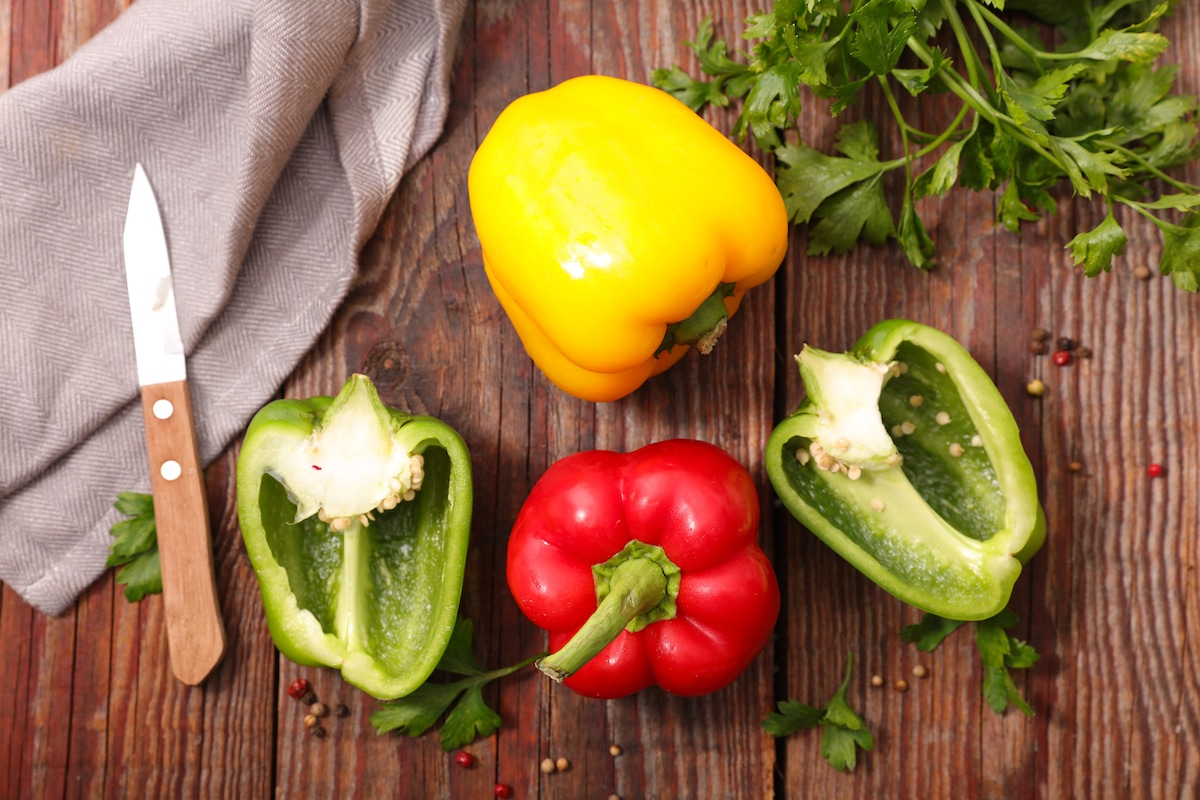
11. Bell peppers
Bell peppers are a large, bell-shaped variety of Capsicum annuum (chili pepper) that don’t contain any capsaicin — the chemical responsible for chili peppers’ characteristic spiciness (27).
They come in a variety of colors, including red, yellow, orange, and green (which are actually unripe red peppers).
Bell peppers have thin skin and crisp, juicy flesh with flavors that range from slightly bitter and grassy, to mildly sweet and citrusy.
A single bell pepper (120 grams) provides between 107% and 245% of the Daily Value for vitamin C, depending on the color, with red peppers containing the most (11, 28, 29, 30).
Fresh, frozen, roasted (jarred), and dehydrated bell peppers are available at most grocery stores. You may even find bell pepper chips! Look for fresh peppers that are firm, with smooth skin and no wrinkles, brown spots, or soft spots.
They can be sliced and served raw in salads or as part of a crudité platter, but they also make a great addition to stir-fries, pizzas, pastas, and soups. Stuffed baked peppers are also an excellent weeknight meal!
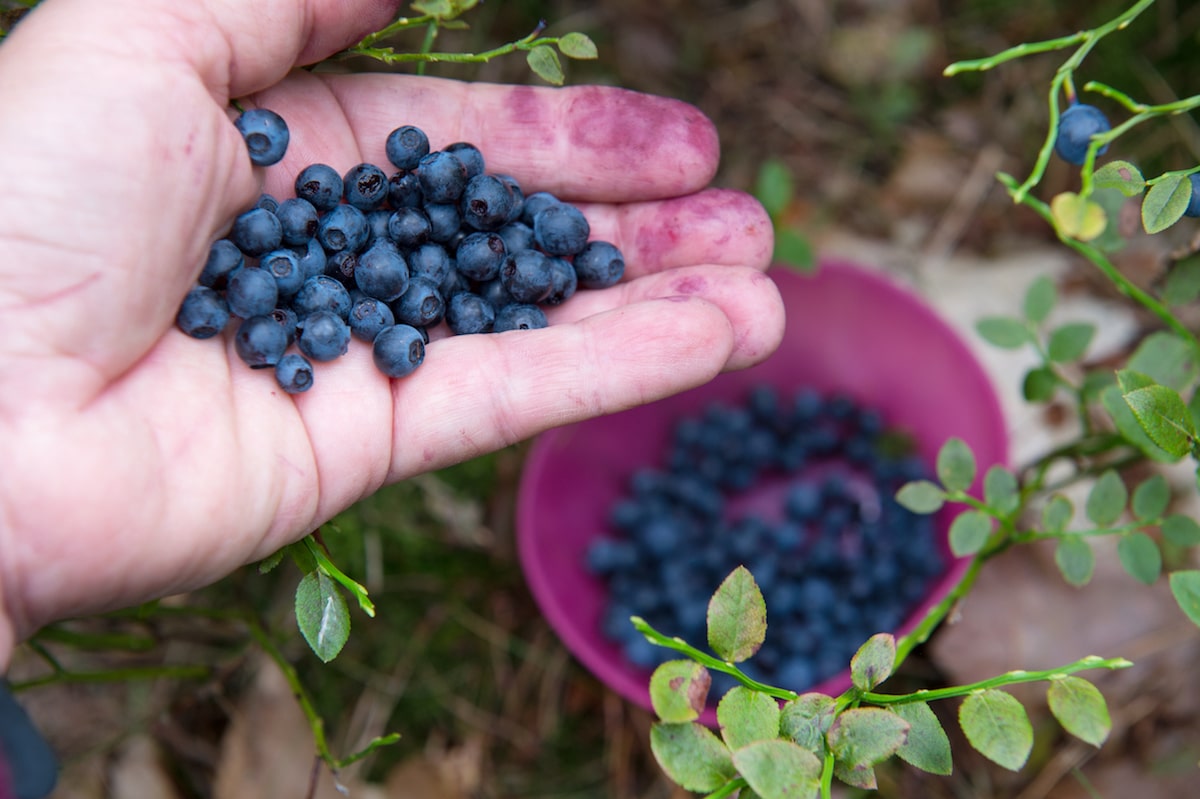
12. Bilberries
Bilberries, also called whortleberries, are the fruits produced by Vaccinium myrtillus L., a shrub native to the forests and mountains of Northern Europe (31, 32).
These delicious fruits are small (about ½ centimeter in diameter) with dark, blue-purple skin and juicy, bright red pulp filled with tiny seeds (31). They look extremely similar to blueberries and are in fact sometimes called European blueberries.
Bilberries are very tart and acidic, so they’re often used to make jams, syrups, and baked goods, including pies and muffins. If you eat them fresh, they may stain your hands a deep crimson.
Nutritionally, bilberries are very similar to blueberries. They’re very high in anthocyanins — a group of purple-red antioxidants — and provide about 10 mg (11% DV) of vitamin C per 100 grams (11, 33, 34).
While fresh bilberries are hard to come by in the United States, you can easily find dried bilberries online here, along with fruit spreads, juices, and powders.

13. Bison
Bison — sometimes mistakenly referred to as buffalo — are large hooved mammals belonging to the family Bovidae, which also includes cattle, sheep, and goats (35, 36).
They are native to North America, where they once roamed the Great Plains in large numbers. Today, most bison meat comes from ranches in the United States and Canada (37, 36).
Their meat is a popular alternative to beef, although it tends to be leaner and has a stronger, grassier flavor.
A 3-ounce (85-gram) serving of cooked ground bison meat contains 17 grams of protein, 6 grams of fat, 2.4 (13% DV) mg of iron, 3.9 mg (35% DV) of zinc, and 1.7 mcg (71% DV) of vitamin B12 (11, 38).
Many grocery stores carry ground bison or bison steaks. It can also be purchased online, from specialty butcher shops, local farmers, or at farmers markets.
Use bison meat in recipes that call for beef, such as burgers, tacos, or meatballs. It’s also delicious in stews, chilis, and pasta dishes.
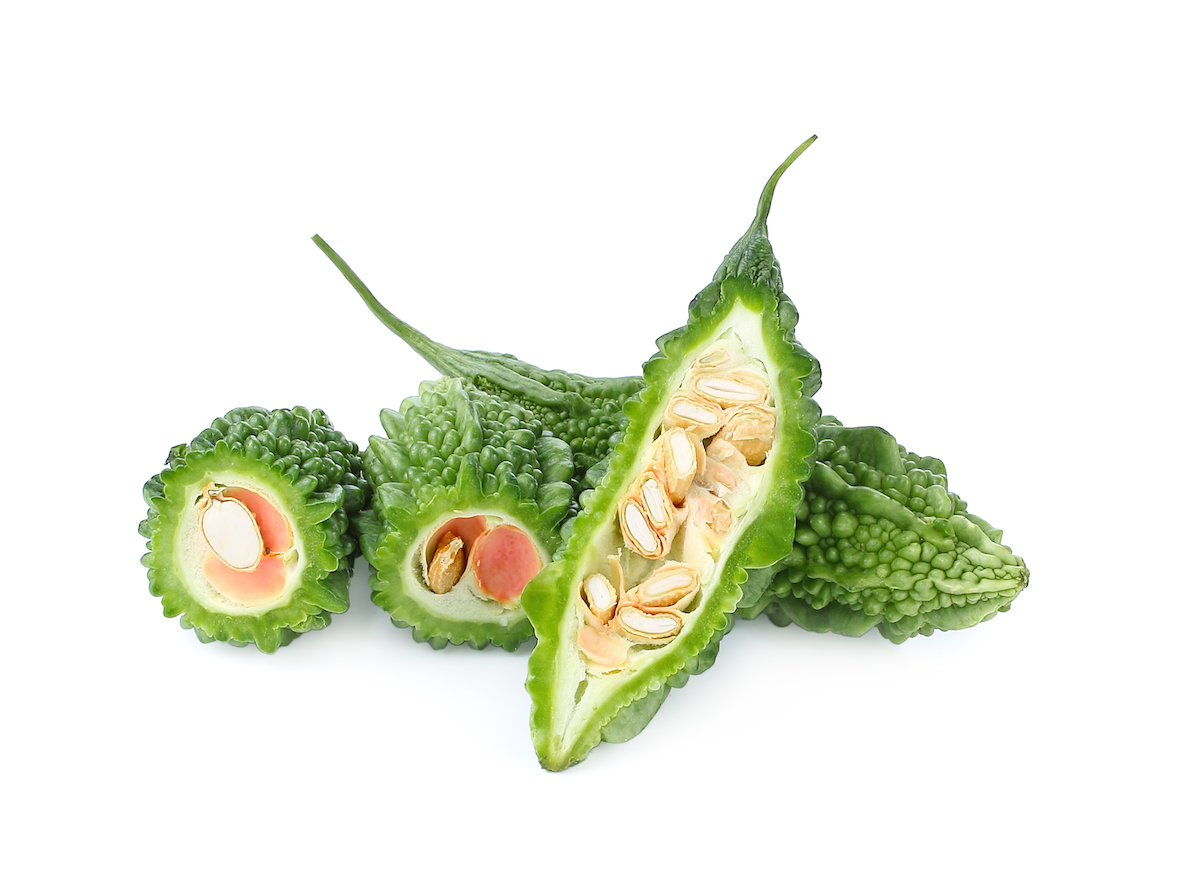
14. Bitter melon
Bitter melon, also called bitter gourd or balsam pear, is a type of fruit that belongs to the Cucurbitaceae family and grows mainly in tropical and subtropical regions (39).
It has a similar shape as a cucumber, but with thicker skin that’s covered in wart-like bumps. Inside, the off-white flesh is filled with large edible seeds that turn red as the fruit ripens.
Bitter melon is aptly named — it is quite bitter and astringent, without even a hint of sweetness. Because of this, it can be an acquired taste.
One cup (130 grams) of bitter melon provides 2.5 grams of fiber, 42 mg (47% DV) of vitamin C, 64 mcg (16% DV) of folate, and 402 mg (9% DV) of potassium (11, 40).
Look for bitter melon at farmers markets, Asian food markets, and specialty produce stores. It can also be purchased online here.
Despite being classified as a fruit, bitter melon is typically used more like a vegetable in stir-fries, soups, and curries.
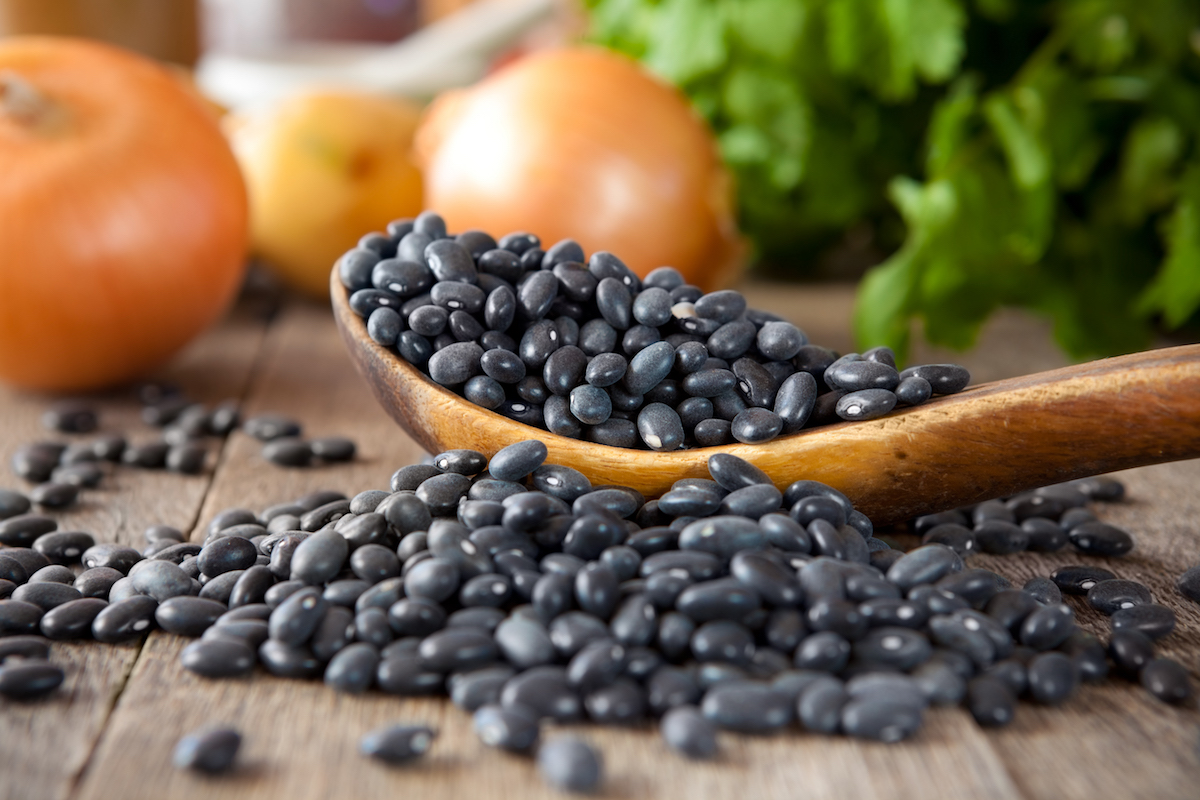
15. Black beans
Black beans, also called black turtle beans, are a variety of the common bean (Phaseolus vulgaris), a type of legume that originated in South America (41, 42).
They are small, about ½ inch long, and oval-shaped with creamy white flesh and black skin that has a slightly purple hue.
Black beans have a mild, earthy flavor with a hint of sweetness, and they soften but hold their shape well when cooked.
One cup (185 grams) of cooked black beans contains a whopping 15 grams of protein, along with more than 20% of the Daily Value for fiber, iron, magnesium, and folate (11, 43).
You can find black beans in most grocery stores, either in the dry bean section or in the canned bean aisle.
Black beans are perfect for a variety of dishes, such as chili, black bean soup, burritos, and even desserts like brownies and dessert hummus.

16. Blackberries
Blackberries are the dark, purple-black fruits produced by several species of shrubs belonging to the genus Rubus, which are native to North America and Europe (44).
Like raspberries, they are classified as an aggregate fruit, meaning they’re formed from one flower but are made up of clusters of smaller single-seeded fruits called drupelets (45).
Blackberries are juicy, sweet, and slightly tart when ripe, but they can be mouth-puckeringly sour if picked too soon.
They are incredibly high in fiber, with 8 grams per cup (150 grams) of raw berries, and they also provide a good amount of vitamin C, folate, and vitamin K (11, 46).
Both fresh and frozen blackberries are typically available year-round at grocery stores in the United States. However, their peak season is from May to September.
Enjoy blackberries on their own, or toss a handful into smoothies, salads, and oatmeal bowls. They’re also perfect for making jams, syrups, cobblers, and other desserts.
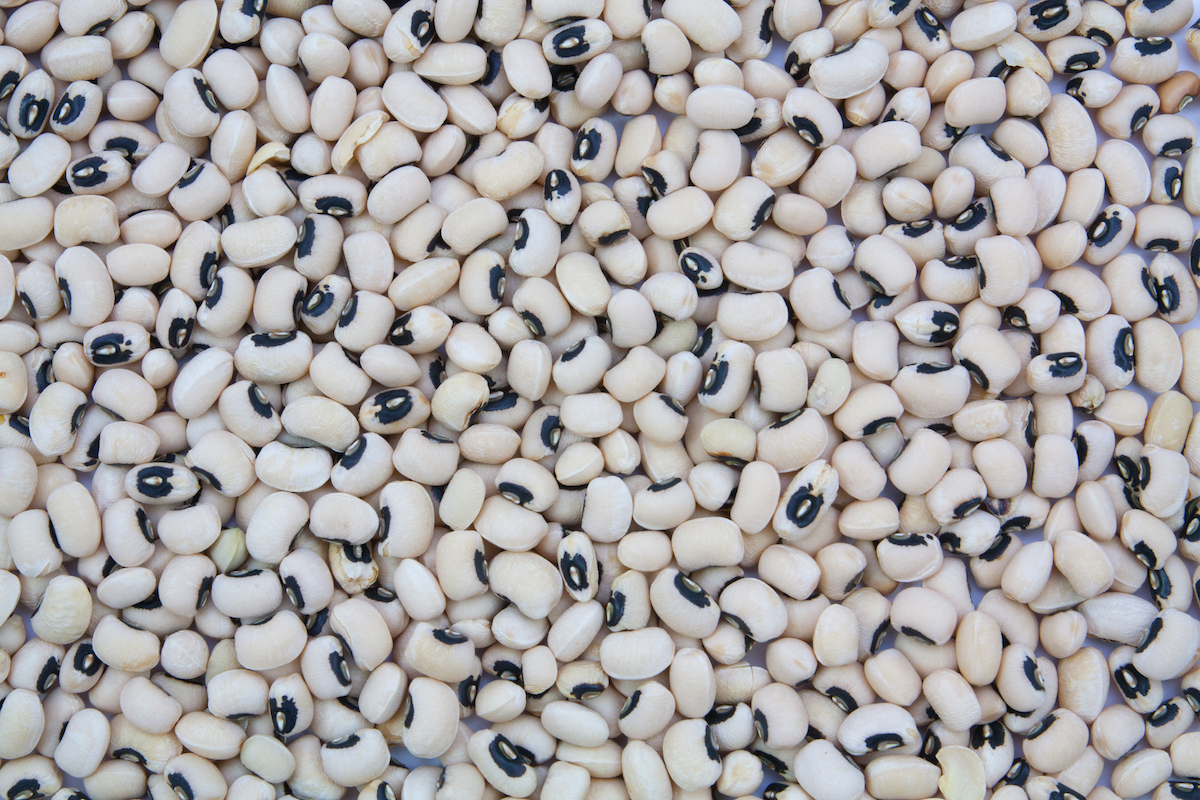
17. Black-eyed peas
Black-eyed peas, also known as cowpeas, are a type of legume that originated in Africa and are very popular in the American South (47).
They are small, tan-colored (or sometimes light green), and have a circular black spot on the side that resembles an eye.
Black-eyed peas have a mild, earthy flavor and firm texture that makes them a versatile ingredient in many dishes, such as Hoppin’ John, a Southern classic.
A one-cup (165-gram) serving of cooked black-eyed peas offers 5 grams of protein, 86 mg (20% DV) of magnesium, 210 mcg (53% DV) of folate, and 44 mcg (37% DV) of vitamin K (11, 48).
You can find black-eyed peas in most grocery stores, either dried or canned. Use them in soups, stews, and chilis, or toss some into salads and side dishes, like cowboy caviar.

18. Blueberries
Blueberries are the berries produced by several species of flowering shrubs belonging to the Vaccinium family, which are native to North America (49, 50).
They are small (about 1 centimeter in diameter) and round, with dark blue-purple skin and pale green flesh.
Blueberries are known for their sweet, slightly tart flavor that pairs well with lemon, warm spices, and nuts.
These nutrient-packed berries get their rich color from anthocyanins, a group of plant pigments that reduce inflammation and have been linked with improved heart and gut health (51, 52, 53).
Fresh blueberries are typically available year-round at most supermarkets. Frozen, dried, freeze-dried, and canned blueberries or blueberry juice can also be purchased.
There are many delicious ways to enjoy blueberries — blend them into a smoothie, add them to your salad, or bake them into muffins, pancakes, or pies.
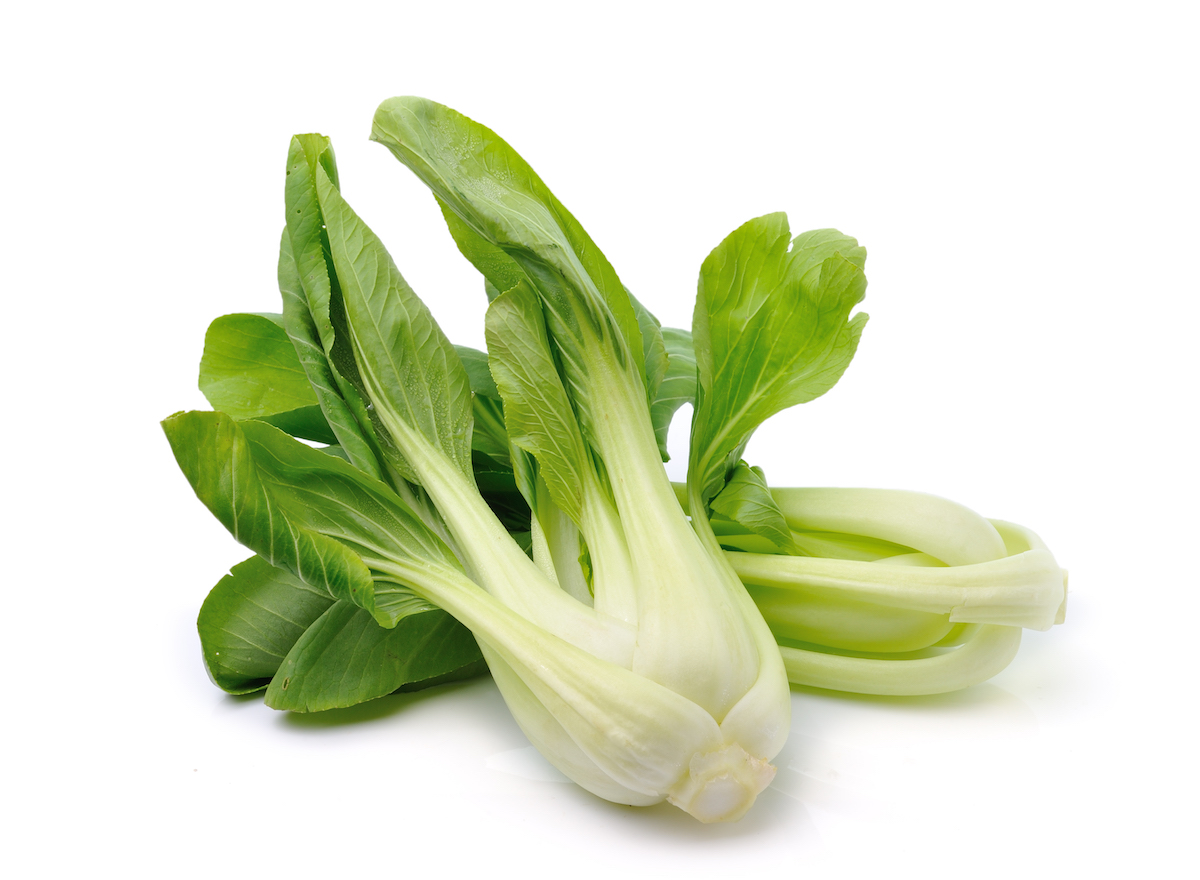
19. Bok choy
Bok choy, also called pak choi or Chinese cabbage, is a leafy green vegetable that belongs to the Brassica family and is very popular in Asian cuisine.
It has long, crunchy white stalks that resemble celery, and large, dark green leaves. The flavor is like a cross between cabbage and spinach, with a slightly peppery taste.
The term “baby bok choy” refers to bok choy that is harvested early — when the stalks and leaves are much smaller. It is more tender and delicate than regular bok choy.
One cup (170 grams) of cooked bok choy provides 158 mg (12% DV) of calcium, 1.8 mg (10% DV) of iron, 44 mg (49% DV) of vitamin C, and 58 mcg (48% DV) of vitamin K (11, 54).
Fresh bok choy can be found year-round at most supermarkets, as well as farmers’ markets and Asian food stores.
Both the leaves and the stalks are edible and are perfect for adding to soups and stir-fries, or simply steaming and serving on their own.
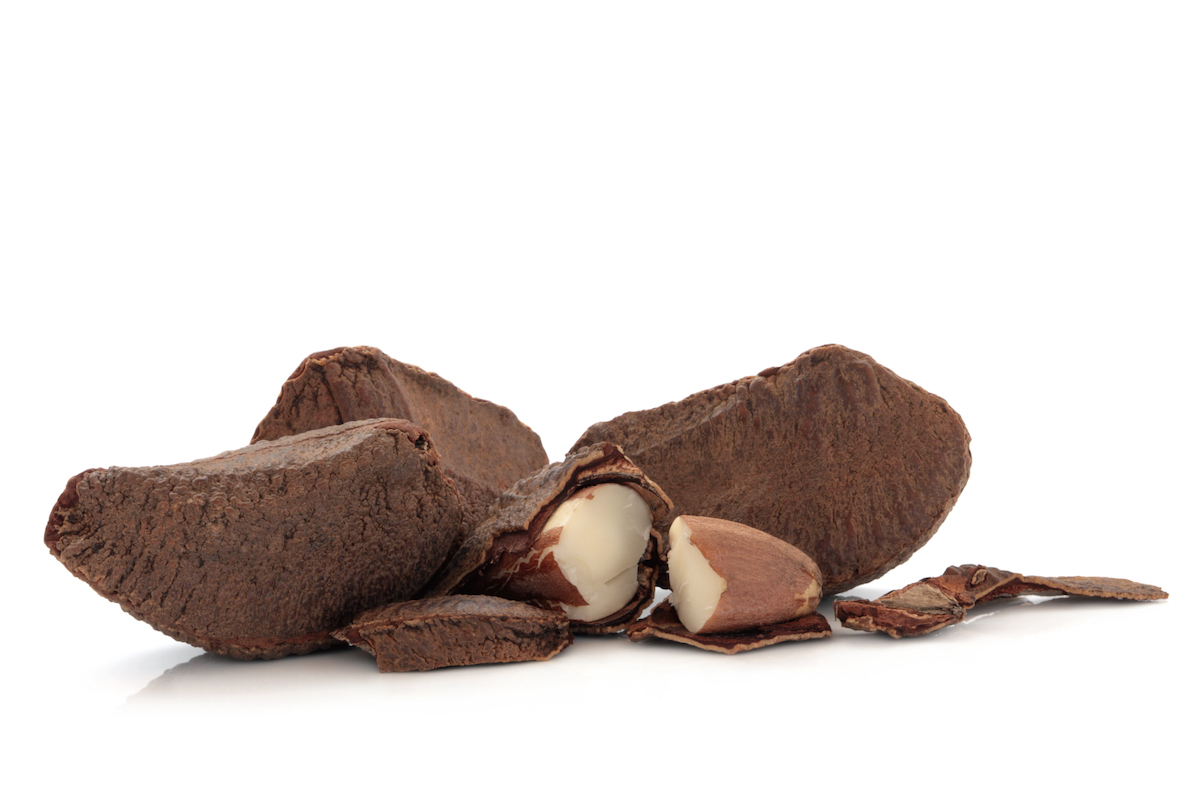
20. Brazil nuts
Brazil nuts are technically the seeds of the Brazil nut tree (Bertholletia excelsa), native to the Amazon rainforest in South America (55).
They are large (up to 2 inches long) with a very tough, dark brown shell that’s shaped somewhat like an orange segment.
Inside the shell, the edible kernel is ivory-colored with patches of papery brown skin. It has a smooth, buttery texture and a mild, nutty flavor.
A single Brazil nut provides almost twice the Daily Value for selenium, a mineral that’s important for thyroid function and fertility (11, 56, 57, 58).
Brazil nuts are often included in mixed nuts products but can also be purchased in the bulk section of supermarkets and health food stores, as well as online.
Enjoy Brazil nuts as a snack on their own, or add them to your favorite trail mix. They can also be chopped and used as a topping for oatmeal, pancakes, or waffles.
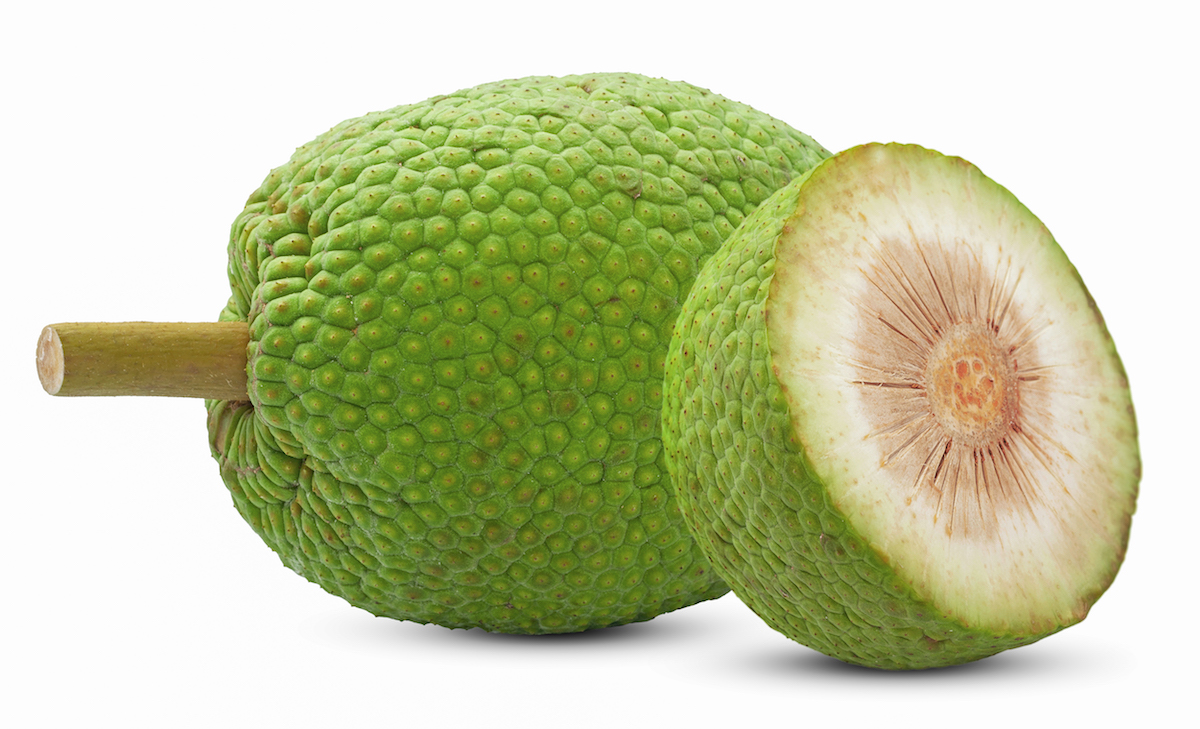
21. Breadfruit
Breadfruit, also called ulu, is a fruit that originated in Southeast Asia and is now grown in tropical climates throughout the world (59, 60).
It is large (8-10 inches in diameter) and oblong with bumpy yellow-green or green-brown skin and starchy, cream-colored flesh that sweetens slightly as it ripens.
When fully ripe, breadfruit tastes a bit like freshly baked bread — hence the name — although its flavor and texture has also been compared to potatoes.
One cup (170 grams) of cooked breadfruit provides 45 grams of carbohydrates, 5 grams of fat, 8 grams (29% DV) of fiber, 808 mg (17% DV) of potassium, and 41 mg of vitamin C (46% DV) (11, 61).
Breadfruit is available fresh or canned at Asian and Latin food markets, as well as specialty produce stores. It can also be purchased online here and here. You may find breadfruit chips for breadfruit flour for sale as well.
This unique fruit can be used in both sweet and savory dishes. Try using it in curries, soups, and stews, as well as desserts like cakes and puddings.

22. Broccoli
Broccoli is a popular vegetable and member of the Brassica family, which includes other cruciferous vegetables like kale, cabbage, and cauliflower (62).
It resembles a miniature tree, with a thick green stem that branches out into small, darker green florets.
The tender florets are crunchy and have a bitter, peppery flavor that mellows out when cooked, while the stalk is fairly tough and has a milder flavor.
A one-cup (90-gram) serving of raw broccoli provides nearly 90% of the Daily Value for vitamin C, along with a good amount of fiber, folate, and vitamin K (11, 63).
Both fresh and frozen broccoli are available at supermarkets. Look for bright green florets with no yellowing or browning, and avoid any that have wilted leaves. Also keep an eye out for broccoli leaves, which look similar to collard greens, but have a sweeter, more mild taste.
Broccoli florets can be enjoyed raw in salads or dipped in hummus. They can also be steamed, boiled, stir-fried, or roasted. Peel the stem and enjoy the tender inner portion and cook up the leaves as well if you can find them!
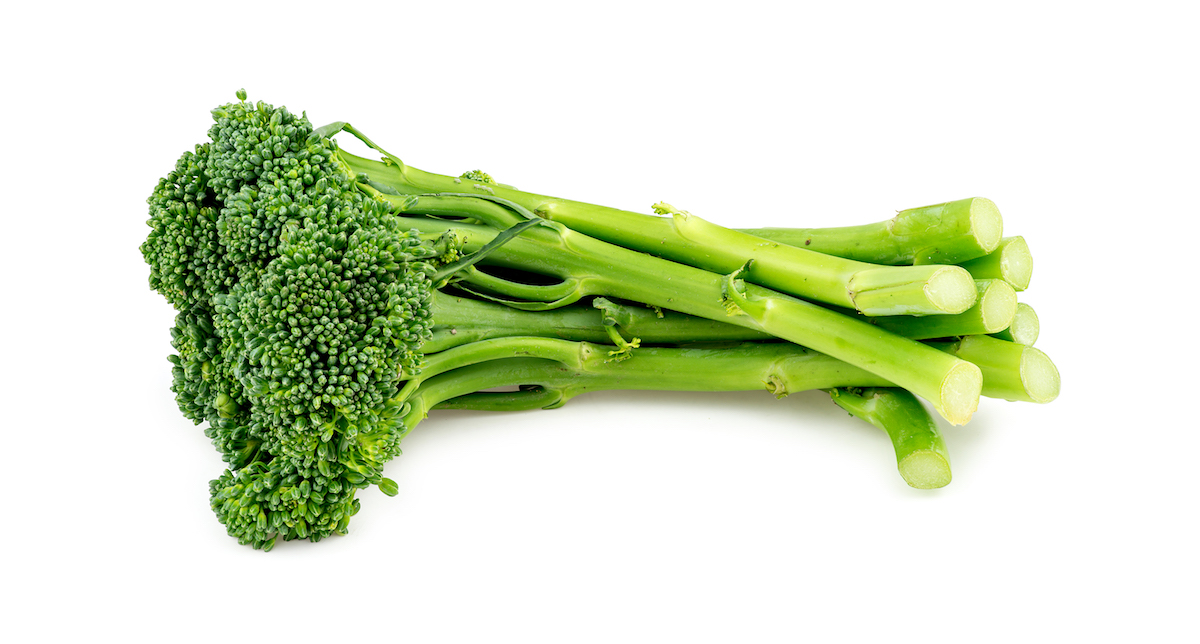
23. Broccolini
Broccolini, also sometimes called “baby broccoli,” is a hybrid vegetable created by crossing broccoli with gai lan (Chinese kale) (64).
It looks and tastes very similar to broccoli, but with thinner stalks, smaller florets, and a sweeter, milder flavor.
Like other cruciferous vegetables, broccolini is high in sulforaphane, an antioxidant compound that may help protect against cancer (65).
Fresh broccolini can be found in many supermarkets, farmers’ markets, and natural food stores.
Broccolini can be enjoyed cooked or raw. Some popular ways to prepare it include steaming, roasting, stir-frying, and eating it raw in salads.
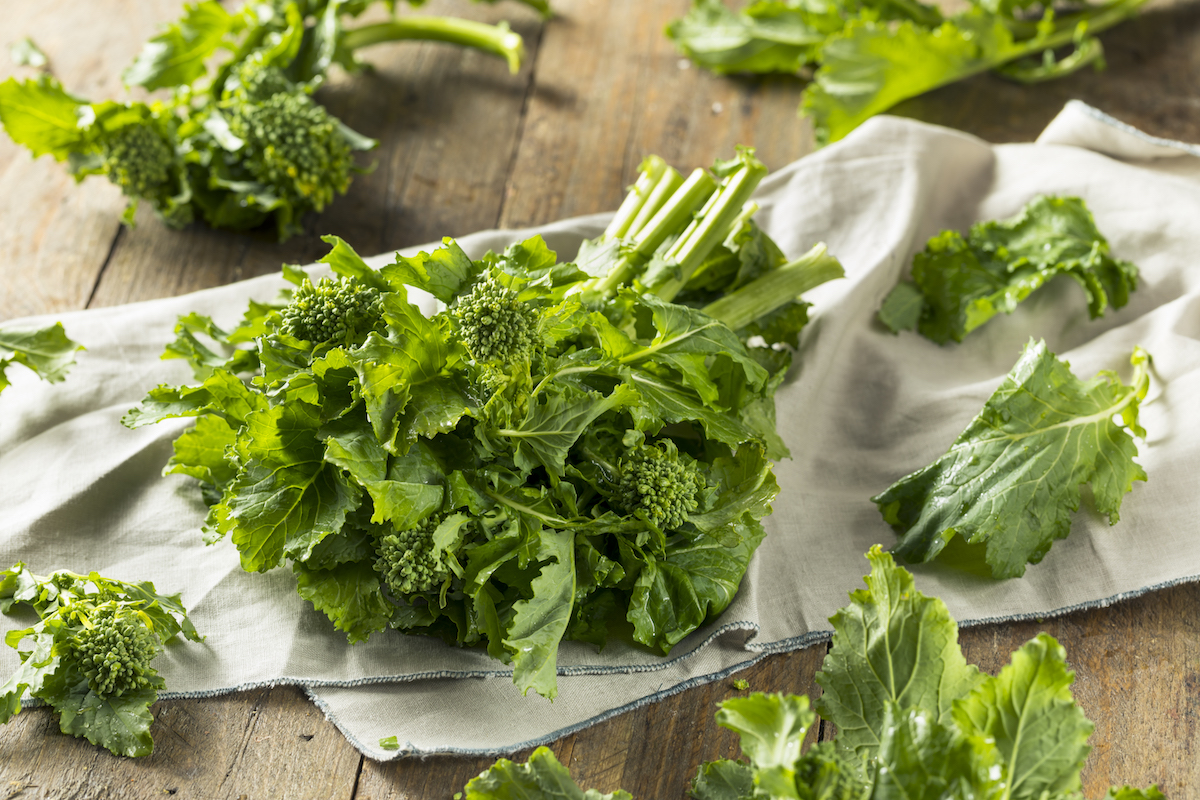
24. Broccoli rabe
Broccoli rabe, also called broccoli raab or rapini, is a leafy green vegetable belonging to the Brassica family, and is believed to have originated in southern Italy (66).
It has dense, dark green leaves and thin stalks ending in small, clustered buds that resemble smaller broccoli florets, all of which are edible.
While the buds taste similar to broccoli, the leaves and stems are pungent and bitter, especially when eaten raw. Cooking is recommended to help to mellow these flavors. A quick blanch in boiling water before sautéing helps immensely.
One cup (40 grams) of raw broccoli rabe provides 1 gram of fiber, 52 mcg (6% DV) of vitamin A, and 90 mcg (75% DV) of vitamin K (11, 67).
Fresh broccoli rabe is available at many farmers’ markets and grocery stores, especially those with a wide selection of produce.
A popular way to prepare broccoli rabe is to sauté it with garlic and olive oil, but it can also be steamed, boiled, or roasted.
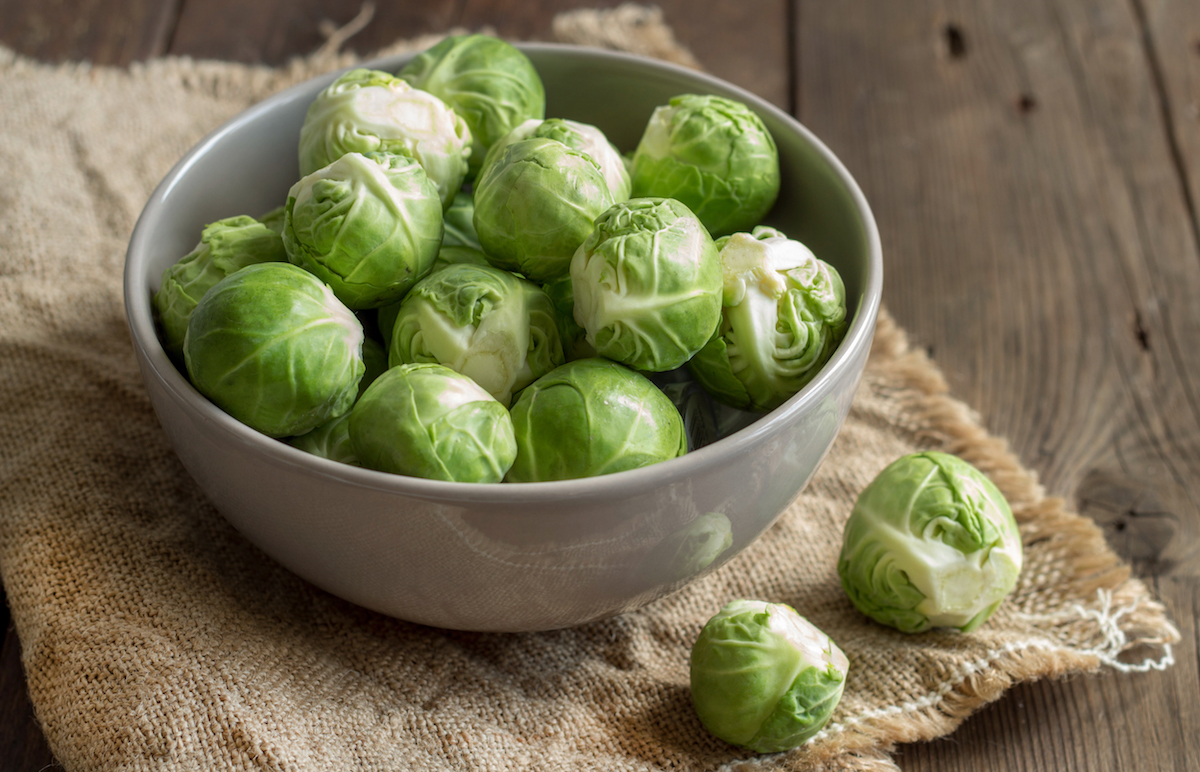
25. Brussels sprouts
Brussels sprouts are members of the Brassica (cabbage) family, and are thought to have originated in Brussels, Belgium — hence their name (68).
They look like miniature cabbages — about an inch in diameter with tightly packed green leaves — and have an earthy, slightly bitter flavor.
One cup (90 grams) of raw Brussels sprouts provides 3 grams of protein, 3 grams of fiber, 77 mg (86% DV) of vitamin C, and 159 mcg (133% DV) of vitamin K (11, 69).
While you can find fresh Brussels sprouts year-round, they’re in peak season from late August through March. Frozen Brussels sprouts are also available at most stores.
To prepare Brussels sprouts, remove any yellow or wilted leaves, then slice them in half lengthwise before steaming, roasting or sautéeing.
Raw Brussels sprouts can also be shredded and used in salads or slaws. If you’re not a fan of the slightly bitter taste, massaging the leaves with a bit of oil can help to mellow it out.

26. Buckwheat
Buckwheat refers to the small, triangular seeds of plants belonging to the genus Fagopyrum, which grow mainly in the northern hemisphere (70).
It is classified as a pseudocereal, a group of seeds that have similar properties to cereal grains, both nutritionally and in the way they’re consumed (71).
When cooked, it has a chewy texture and a nutty, earthy flavor with just a hint of bitterness. Toasting the buckwheat groats before cooking is often recommended to enhance their flavor.
Despite its name, buckwheat is unrelated to wheat and contains no gluten, making it a good choice for people with celiac disease or gluten intolerance.
While buckwheat groats and flour may be available at some supermarkets, you’re most likely to find them at health food stores. They can also be purchased online here and here.
Buckwheat can be used in a variety of recipes, including pilafs, salads, soups, and stuffings. It can also be ground into a flour and used to make pancakes, crepes, or pasta.
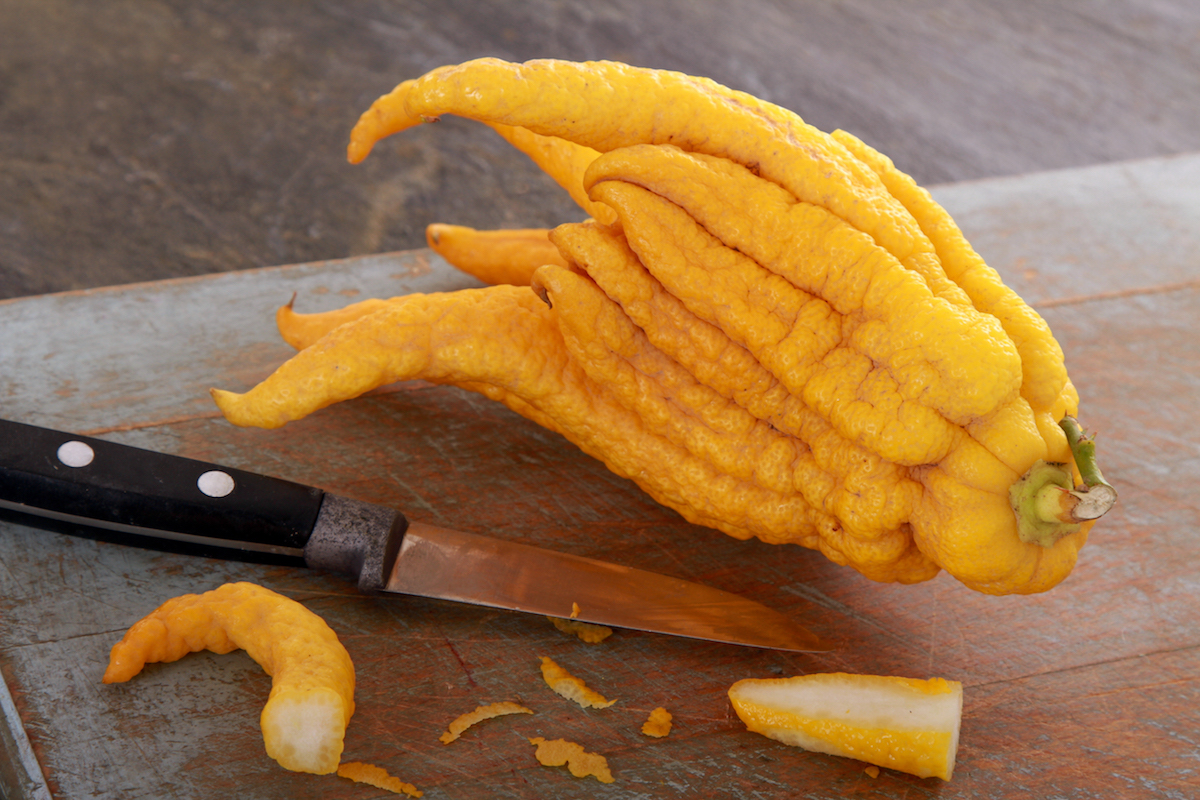
27. Buddha’s hand
Buddha’s hand (also known as finger citron) is a type of citron, a large citrus fruit with a very thick rind and little to no pulp (72).
Its unique shape somewhat resembles two hands in a prayer position, hence the name, or an octopus with lots of tentacles.
The fruit’s bright yellow rind is bittersweet and fragrant, with a scent like a cross between lemon and lavender, and inside it is filled with a very bitter, spongy white pith.
Although it is mainly grown in Asia, you may be able to find Buddha’s hand at farmers markets in California. Another option is to purchase it online here or here.
Buddha’s hand can be chopped and candied or zested and used in baked goods, salad dressings, infused salts, and cocktails.
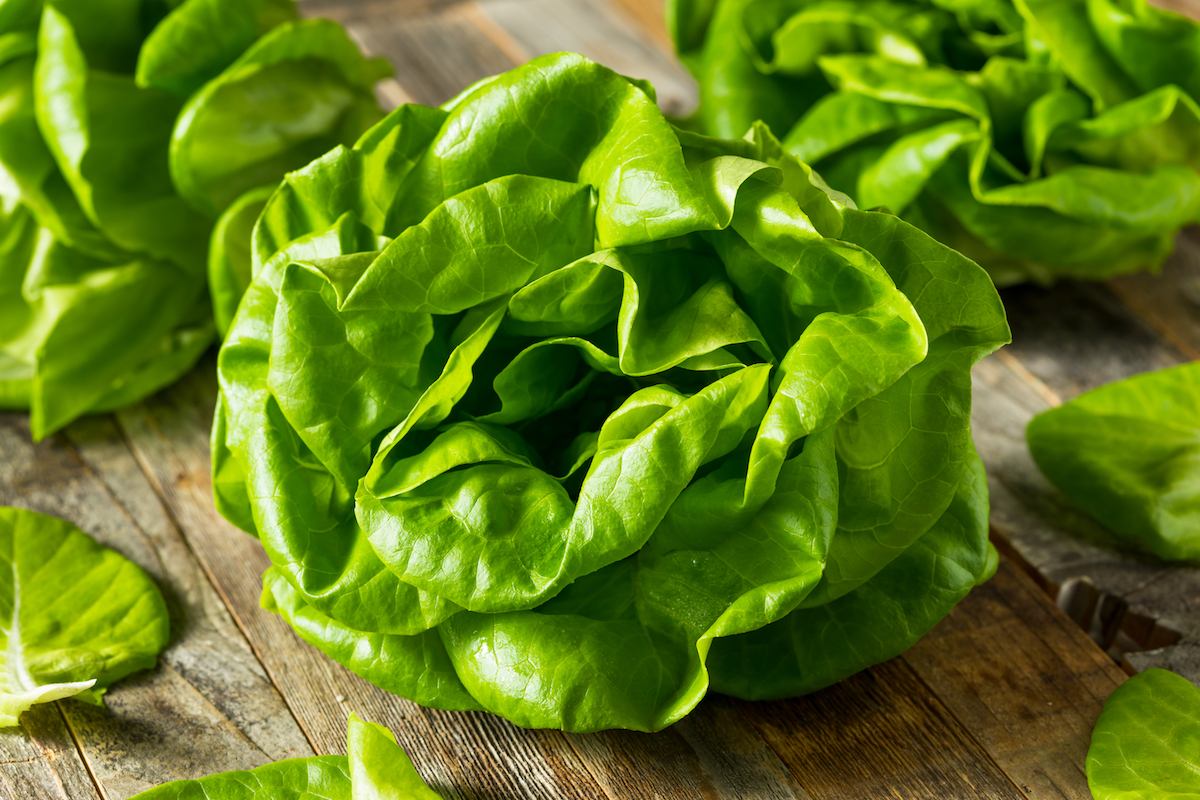
28. Butter lettuce
Butter lettuce (also called Bibb lettuce) is a variety of head lettuce with bright green, buttery soft leaves arranged in a loosely formed head.
The tender leaves have a very mild flavor with just a hint of sweetness and pair well with vinaigrettes, fruits, and savory meats.
Like other lettuces, it is very low in calories and carbohydrates while providing a good amount of folate, vitamin A, and vitamin K (73).
At most supermarkets, you’ll find heads of butter lettuce packaged in plastic clamshell containers, and it is also sometimes included in bagged salad blends.
Because it doesn’t snap apart when bent, butter lettuce is the perfect leafy green for making wraps filled with taco meat, chicken salad, or even burgers.
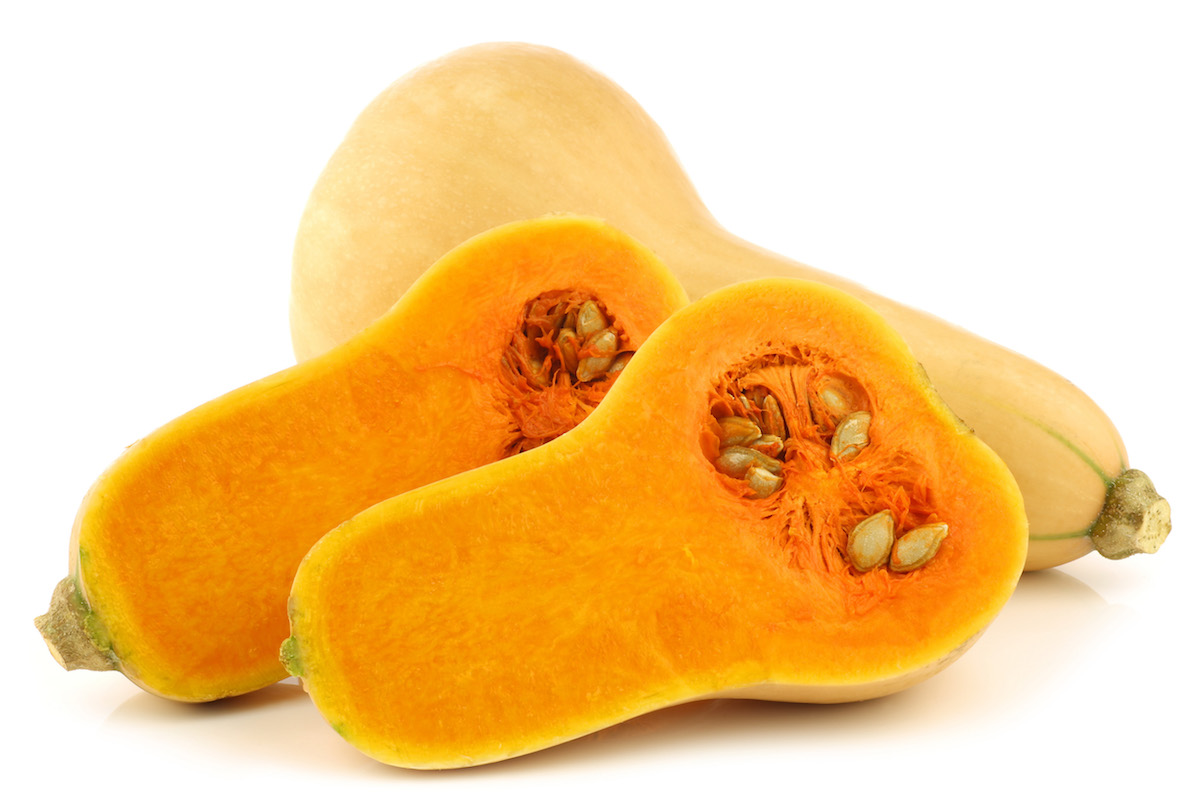
29. Butternut squash
Butternut squash is a type of winter squash belonging to the species Cucurbita moschata, which originated in Central and South America (74, 75).
It is medium-sized (up to 12 inches long) and shaped like an elongated pear, with tan-colored skin and a seed-filled compartment in the wider end.
Its bright orange flesh tastes similar to sweet potatoes but has more of a nutty flavor and a softer, buttery texture when cooked.
Butternut squash is one of the best food sources of vitamin A, providing 1140 mcg (127% DV) in a single cooked cup (205 grams) (11, 76).
Despite being classified as a winter squash, both fresh and frozen forms are typically sold year-round in the produce section of most supermarkets.
To enjoy butternut squash, simply cut it in half lengthwise, scoop out the seeds, and roast flesh-side down on a lightly oiled baking sheet at 400°F (204°C) for 30 minutes.
Final thoughts
From bamboo shoots to butternut squash, there are plenty of delicious foods that start with the letter B.
We hope this list has inspired you to be adventurous and try some new foods, or to gain a new appreciation for some of the foods you already eat every day.
For more foodie inspiration, check out our full list of foods from A to Z.
Amy Richter is a Registered Dietitian Nutritionist based in Missouri. She is an experienced nutrition writer and medical advisor for Healthline and Medical News Today. Amy is passionate about all things food-related and enjoys translating complex science into easy-to-understand articles.
Medical Nutrition Board Member | Registered Dietitian Nutritionist
Erica Julson is a Registered Dietitian Nutritionist based in sunny California. She has over a decade of experience in food writing and recipe development and is the proud founder of four blogs in the food and nutrition space. Erica has also been part of Healthline's Nutrition Team and is an expert at translating research into helpful information for readers.
Credentials:
- Registered Dietitian Nutritionist (RDN)
Education:
- M.S in Nutritional Science - Cal State Los Angeles
- B.S in Psychobiology - UCLA
Experience:
- Over 10 years of experience in food and nutrition journalism.
- Former medical nutrition writer for Healthline Nutrition.
- Six years of experience working in research labs at UCLA and Carnegie Mellon University.
- Co-author on four peer-reviewed journal articles.
- Completed 1,200 hours of supervised practice to become a Registered Dietitian Nutritionist.
- Interviewed on many popular podcasts, featured on the local news, and quoted in magazines.

